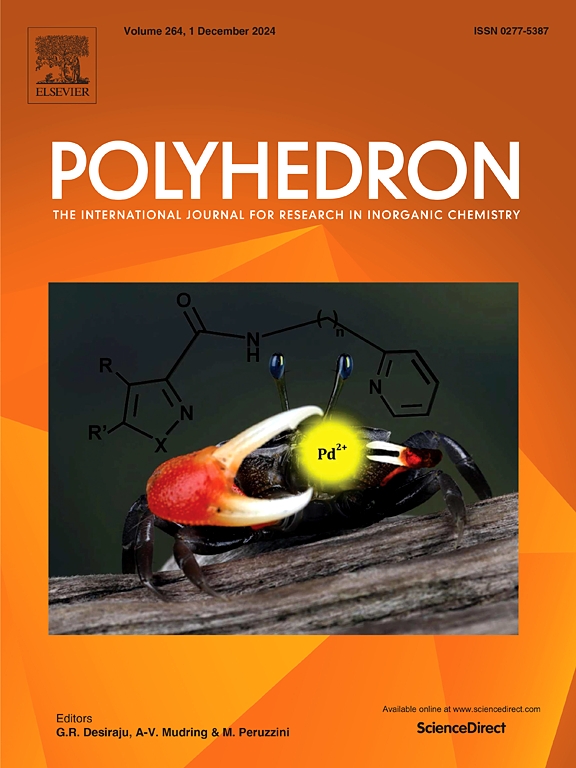Structural variations in Co(II), Co(III) and Zn(II) complexes of a chiral triphenolic macrocycle
IF 2.4
3区 化学
Q2 CHEMISTRY, INORGANIC & NUCLEAR
引用次数: 0
Abstract
Five homonuclear cobalt(II) and zinc(II) complexes and two mixed-valence Co(II)/Co(III) coordination species derived from the enantiomers of the macrocycle H3L were synthesized, characterized by spectroscopic methods and their X-ray crystal structures were determined. The large macrocyclic amine L3− composed of three phenol moieties and three trans-1,2-diaminocyclohexane units can accommodate three Co(II), Co(III) or Zn(II) ions in three N2O2 compartments, forming [M3L]n+ type complexes. The geometry of these complexes is different for the Zn(II) and Co(II) ions and depends on the counteranion used. Additionally, this macrocycle binds only two metal ions in its partly deprotonated (H2L)− form to give complexes of the type [M2(H2L)]n+. Amine H2L− also forms a tetranuclear [M4(H2L)2]n+ complex, where two macrocyclic units are additionally connected by bridging anions. XRD structures of seven additional coordination species that were isolated as single crystals are also presented.

手性三酚类大环Co(II)、Co(III)和Zn(II)配合物的结构变化
合成了由大环H3L对映体衍生的5个同核钴(II)和锌(II)配合物和2个混价Co(II)/Co(III)配位物,用光谱方法对其进行了表征,并测定了它们的x射线晶体结构。由3个苯酚基团和3个反式-1,2-二氨基环己烷单元组成的大环胺L3−可以在3个N2O2腔室中容纳3个Co(II)、Co(III)或Zn(II)离子,形成[M3L]n+型配合物。这些配合物的几何形状对于Zn(II)和Co(II)离子是不同的,并且取决于所使用的反阴离子。此外,这个大环只结合两个部分去质子化(H2L)−形式的金属离子,形成[M2(H2L)]n+类型的配合物。胺H2L−也形成一个四核[M4(H2L)2]n+配合物,其中两个大环单元通过桥接阴离子额外连接。另外7种配位物的XRD结构也被分离为单晶。
本文章由计算机程序翻译,如有差异,请以英文原文为准。
求助全文
约1分钟内获得全文
求助全文
来源期刊

Polyhedron
化学-晶体学
CiteScore
4.90
自引率
7.70%
发文量
515
审稿时长
2 months
期刊介绍:
Polyhedron publishes original, fundamental, experimental and theoretical work of the highest quality in all the major areas of inorganic chemistry. This includes synthetic chemistry, coordination chemistry, organometallic chemistry, bioinorganic chemistry, and solid-state and materials chemistry.
Papers should be significant pieces of work, and all new compounds must be appropriately characterized. The inclusion of single-crystal X-ray structural data is strongly encouraged, but papers reporting only the X-ray structure determination of a single compound will usually not be considered. Papers on solid-state or materials chemistry will be expected to have a significant molecular chemistry component (such as the synthesis and characterization of the molecular precursors and/or a systematic study of the use of different precursors or reaction conditions) or demonstrate a cutting-edge application (for example inorganic materials for energy applications). Papers dealing only with stability constants are not considered.
 求助内容:
求助内容: 应助结果提醒方式:
应助结果提醒方式:


